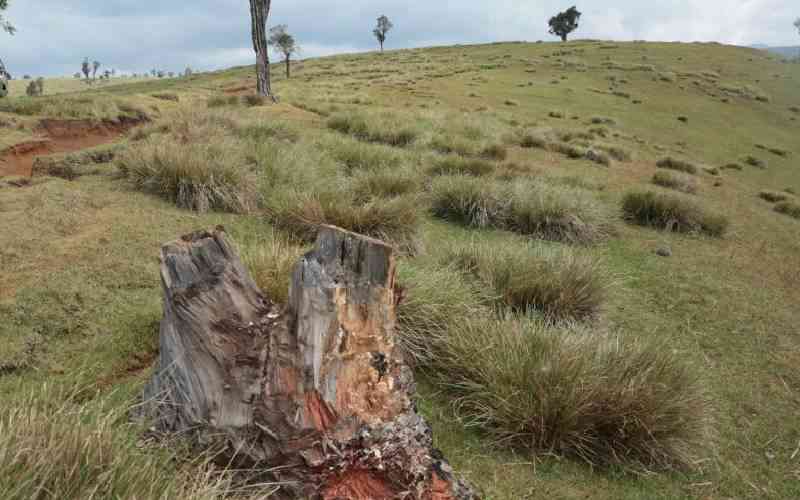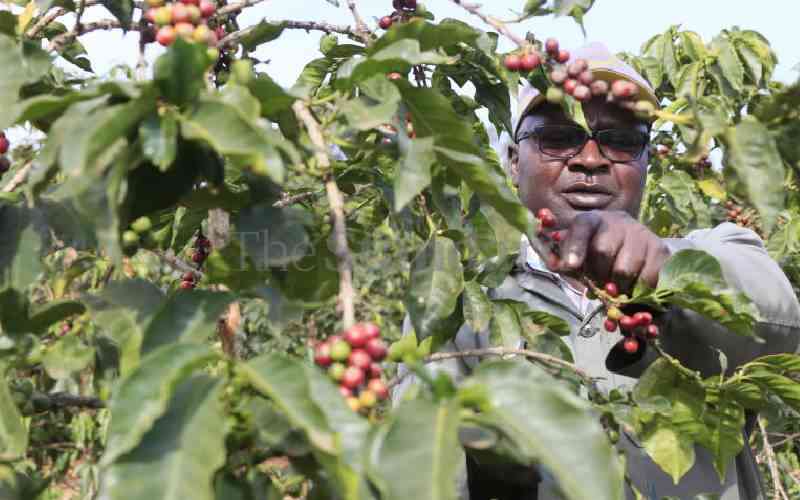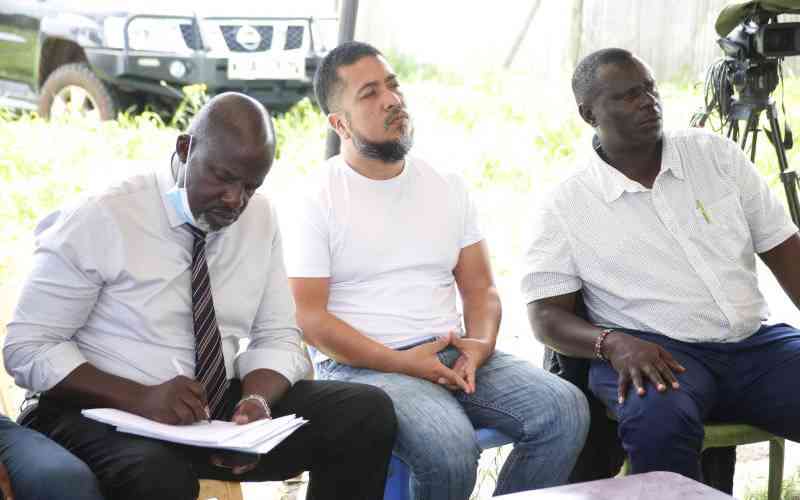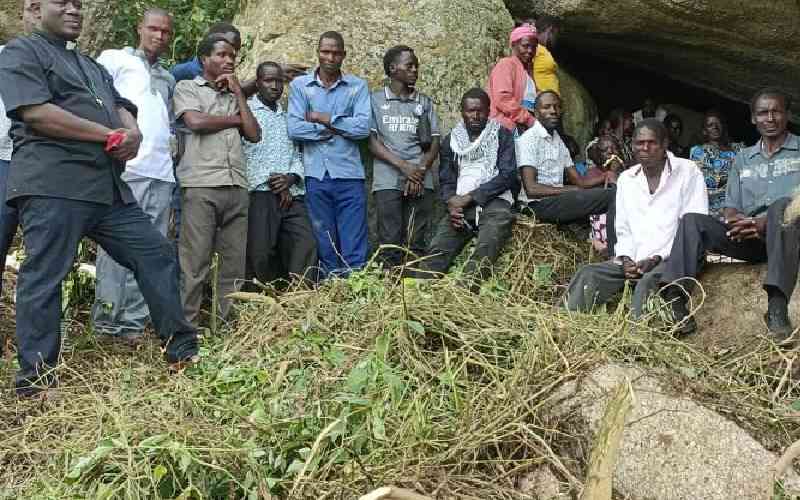By JOE OMBUOR
As the world bids farewell to environment conservation prodigy, Prof Wangari Muta Maathai, efforts must be made to resuscitate a river whose water she and people on the slopes of Mount Kenya once cherished.
Gakina River rose from the green entrails of Karima forest in President Kibaki’s Othaya constituency and gurgled with what was considered holy water through Maathai’s Tetu constituency to join the labyrinth of other rivers and rivulets that combine to form the mighty Tana, Kenya’s largest river. Like many other water sources, Gakina has since dried up contributing to the shrinking of the Tana, thanks to the wanton destruction of Karima forest.
Older folks say that when Gakina River flowed, its water was fetched far and wide for domestic and ritualistic chores, including the cleaning of circumcision implements, washing the initiates and blessing loved ones leaving home for outdoor errands.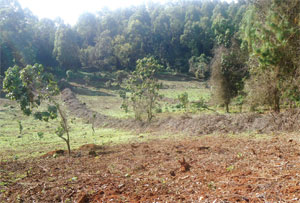 |
The destroyed Karima forest looks desolate. [PICTURE: JOE OMBUOR/STANDARD] |
Elders used Gakina river water to wash the hands before sacrificial ceremonies, sprinkle the sacrificial site to cleanse it of impurities and to wash knives to be used in ceremonies to reach out to Ngai (God) for divine intervention.
Folks around Karima say Wangari Maathai strived to resuscitate the river through her Greenbelt Movement by planting indigenous tree seedlings in the receding forest, but her efforts were frustrated by powerful individuals involved in illegal logging.
Now they are pleading with their local Member of Parliament, President Kibaki to stop the plunder and preserve the forest for posterity and as a lasting honour to the departed Nobel Laureate, who before her divorce in 1979 had her marital home at the river’s banks.
"You knew Karima River, Mr President, because you crossed it many times as a child while attending Karima Primary School. Stop these greedy people destroying our cherished heritage if only as a fitting honour to Prof Maathai who you acknowledge did a commendable job in her determined endeavour to conserve the environment," implores 97-year-old Mzee Mwai wa Karime, a respected member of the community. The school where President Kibaki had his formative academic years overlooks the forest and hill after which it was named.
Karima is home to a holy Agikuyu shrine and seat of Ngai (God) that even the brazen colonialists could not dare destroy for fear of unknown repercussions. Says Mzee wa Karime: "It is believed Ngai stepped here when he jumped from Mount Kenya to the land yonder," he says. The heart and artery of the shrine is a Mugumo (Fig) tree that Mzee wa Karime says looked much the same when he was a child. The tree is believed to be over 400 years old.
"Sacrifices to Ngai for rain and other requests were offered at the foot of this tree after its lush circumference was sprinkled with holy water fetched from Gakina river," says wa Karime who was present at the last such ceremony in 1961. He was 47. Others who were present at the last sacrifice offering ceremony are 96-year-old Muchiri wa Njagi, 89-year-old Naaman Kiori and Ndirangu wa Karuga, 84; all members of the Save Karima Sacred Forest Community Based Organisation.
The Mugumo tree is a wonder to behold with its sheer majesty towering over the dense undergrowth, its rugged trunk gnarled like the skin of a jumbo. The tree’s hanging and real roots are phenomenal, with the latter resembling independent trees conjoined to the mother in a Siamese manner.
The interlocking has created cavernous caves where many small and big reptiles, mammals and amphibians have a home. Up in the mighty branches of the Mugumo is a world populated by birds of all sizes and sounds and the shrill voiced cicadas that seem to be perpetually singing for the extremely rare Colobus Monkeys also considered holy by the Agikuyu and traceable only at shrines.
Under the behemoth that is the sacred Mugumo tree and pockets of the forest that have survived destruction are a medley of medicinal and culturally important plants that the community relied on to cure illnesses and consummate various traditional ceremonies. They include mukoe, muthireti and mururuwe, effective remedies for the common cold, muchatha that was used to treat small pox before the disease was eradicated.
Stay informed. Subscribe to our newsletter
Muheretu was preferred as toothbrush for its medicinal ingredients against dental disorders. Its root is boiled together with bones to prepare a health boosting broth and soup recommended for lactating mothers and the elderly. The mutundu helps heal wounds.
Others were important for their traditional or utility uses. Take the muthakwa for instance. Its leaves were regarded as naturally clean enough to keep infections at bay and were fetched for girls to sit on during circumcision, a custom that has since fizzled out. In the olden days when female genital mutilation (FGM) was in vogue, the leaves of the muthakwa were inserted into the initiates’ genitals to stop blood from flowing in and to facilitate the healing process.
Muthakwa leaves were fetched almost as a rule whenever an animal was to be slaughtered while its branches served as natural grills to place meat for roasting. At a time when toilet papers were unknown, the wide soft leaves of maigoya, shrubs perfectly served the purpose.
Even natural handkerchiefs were available in the forest where the leaves of mwandwe and mutathi plants were used to wipe away sweat. Marathi leaves were also carried as sign of peace. With the forest currently under threat of annihilation, the richness of its fauna and flora may now only be read in books. This is the disaster the Karima community is trying to prevent through a combined effort of elders and energetic youths who are determined to ensure its survival. The death of Wangari Maathai adds vim and vigour to that effort, avers Mwangi Geita, one of the leaders on the youthful front of saving the forest.
The Community conservation chairman, 67-year-old John Kwirika Mbuthia accuses the Provincial Administration in Othaya District of complicity in the destruction of the forest, an accusation the office vehemently denies. Mbuthia claims the Provincial Administration has at times sent up to 60 police officers to protect illegal loggers when he detects signs of community uprising. This, he says, happened on July 27, 2011 when people dug trenches across the only road leading to the forest to stop the loggers.
 The Standard Group Plc is a
multi-media organization with investments in media platforms spanning newspaper
print operations, television, radio broadcasting, digital and online services. The
Standard Group is recognized as a leading multi-media house in Kenya with a key
influence in matters of national and international interest.
The Standard Group Plc is a
multi-media organization with investments in media platforms spanning newspaper
print operations, television, radio broadcasting, digital and online services. The
Standard Group is recognized as a leading multi-media house in Kenya with a key
influence in matters of national and international interest.
 The Standard Group Plc is a
multi-media organization with investments in media platforms spanning newspaper
print operations, television, radio broadcasting, digital and online services. The
Standard Group is recognized as a leading multi-media house in Kenya with a key
influence in matters of national and international interest.
The Standard Group Plc is a
multi-media organization with investments in media platforms spanning newspaper
print operations, television, radio broadcasting, digital and online services. The
Standard Group is recognized as a leading multi-media house in Kenya with a key
influence in matters of national and international interest.




